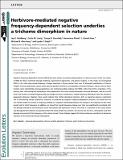Herbivore-mediated negative frequency-dependent selection underlies a trichome dimorphism in nature
Abstract
Negative frequency‐dependent selection (NFDS) has been shown to maintain polymorphism in a diverse array of traits. The action of NFDS has been confirmed through modeling, experimental approaches, and genetic analyses. In this study, we investigated NFDS in the wild using morph‐frequency changes spanning a 20‐year period from over 30 dimorphic populations of Datura wrightii. In these populations, plants either possess glandular (sticky) or non‐glandular (velvety) trichomes, and the ratio of these morphs varies substantially among populations. Our method provided evidence that NFDS, rather than drift or migration, is the primary force maintaining this dimorphism. Most populations that were initially dimorphic remained dimorphic, and the overall mean and variance in morph frequency did not change over time. Furthermore, morph‐frequency differences were not related to geographic distances. Together, these results indicate that neither directional selection, drift, or migration played a substantial role in determining morph frequencies. However, as predicted by negative frequency‐dependent selection, we found that the rare morph tended to increase in frequency, leading to a negative relationship between the change in the frequency of the sticky morph and its initial frequency. In addition, we found that morph‐frequency change over time was significantly correlated with the damage inflicted by two herbivores: Lema daturaphila and Tupiochoris notatus. The latter is a specialist on the sticky morph and damage by this herbivore was greatest when the sticky morph was common. The reverse was true for L. daturaphila, such that damage increased with the frequency of the velvety morph. These findings suggest that these herbivores contribute to balancing selection on the observed trichome dimorphism.
Citation
Goldberg , J K , Lively , C M , Sternlieb , S R , Pintel , G , Hare , J D , Morrissey , M B & Delph , L F 2020 , ' Herbivore-mediated negative frequency-dependent selection underlies a trichome dimorphism in nature ' , Evolution Letters , vol. Early View . https://doi.org/10.1002/evl3.157
Publication
Evolution Letters
Status
Peer reviewed
DOI
10.1002/evl3.157ISSN
2475-0328Type
Journal article
Description
Authors are grateful for funding provided by an NSF GRFP to J.K.G. (2015195769) and DEB‐1353970 to L.F.D.Collections
Items in the St Andrews Research Repository are protected by copyright, with all rights reserved, unless otherwise indicated.

